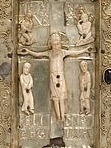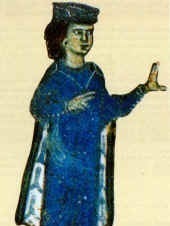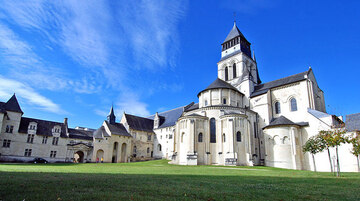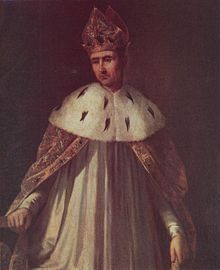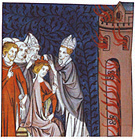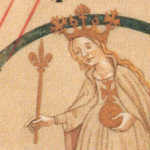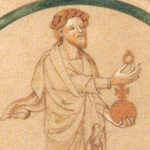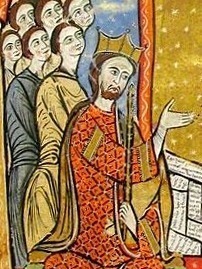Arbre généalogique Snelder - Versteegh » Countess Petronilla of Aragón (1136-1172)
Données personnelles Countess Petronilla of Aragón
Source 1- Elle est née le 29 juin 1136 dans Huesca, Huesca, Aragon, Spain.
 Attention: L'âge au mariage (??-??-1151) était inférieur à 16 ans (15).
Attention: L'âge au mariage (??-??-1151) était inférieur à 16 ans (15). - Profession: Queen of Aragon, Prinsesse av Sverige, Dronning, QUEEN OF ARAGON, Queen of Aragon 1137 - 1164, Abdicated the throne in 1164, QUEEN of ARAGON, Reina de Aragón.
- Elle est décédée le 18 octobre 1172 dans Barcelona, Barcelona, Catalonia, SPAIN, elle avait 36 ans.
- Elle est enterrée dans Barcelona Cathedral, Barcelona, Barcelona, Catalonia, Spain.
- Un enfant de Ramiro II 'el Monje' of Aragón et Agnès of Poitiers
Famille de Countess Petronilla of Aragón
Elle est mariée avec Ramon Berenguer IV "the Saint" of Barcelona.
Ils se sont mariés en l'an 1151, elle avait 14 ans.
Spouse: Ramon Berenguer IV "the Saint" of Barcelona, Count of Barcelona
Enfant(s):
Notes par Countess Petronilla of Aragón
https://en.wikipedia.org/wiki/Petronilla_of_Aragon
Petronilla (29 June[1]/11 August[2] 1136 – 15 October 1173), whose name is also spelled Petronila or Petronella (Aragonese Peyronela or Payronella,[3] and Catalan: Peronella), was the ;Queen of Aragon from the abdication of her father in 1137 until her own abdication in 1164. She was the daughter and successor of Ramiro II by his queen, Agnes. She was the last ruling member of the Jiménez dynasty in Aragon, and by marriage brought the throne to the House of Barcelona.
Petronilla came to the throne through special circumstances. Her father, Ramiro, was bishop of Barbastro-Roda when his brother, Alfonso I, died without an heir in 1134, and left the crown to the three religious military orders. His decision was not respected: the aristocracy of Navarre elected a king of their own, restoring their independence, and the nobility of Aragon raised Ramiro to the throne. As king, he received a papal dispensation to abdicate from his monastic vows in order to secure the succession to the throne. King Ramiro the Monk, as he is known, married Agnes of Aquitaine in 1135; their only child, Petronilla, was born the next year in Huesca. Her marriage was a very important matter of state. The nobility had rejected the proposition of Alfonso VII of Castile to arrange a marriage between Petronilla and his son Sancho and to educate her at his court. When she was just a little over one year old, Petronilla was betrothed in Barbastro on 11 August 1137 to Raymond Berengar IV, Count of Barcelona, who was twenty-three years her senior.[4] At El Castellar on 13 November, Ramiro abdicated, transferred authority to Ramon Berenguer and returned to monastic life.[4] Ramon Berenger de facto ruled the kingdom using the title of "Prince of the Aragonese" (princeps Aragonensis).
In August 1150, when Petronilla was fourteen, the betrothal was ratified at a wedding ceremony held in the city of Lleida.[5] Petronilla consummated her marriage to Ramon Berenguer in the early part of 1151, when she reached the age of 15. The marriage produced five children: Peter (1152–57), Raymond Berengar (1157–96), Peter (1158–81), Dulce (1160–98) and Sancho (1161–1223). While she was pregnant with the first, on 4 April 1152, she wrote up a will bequeathing her kingdom to her husband in case she did not survive childbirth.[6]
While her husband was away in Provence (1156–57), where he was regent (since 1144) for the young Count Raymond Berengar II, Petronilla remained in Barcelona. Accounting records show her moving between there and Vilamajor and Sant Celoni while presiding over the court in Raymond Berengar's absence.[7]
After her husband's death in 1162, Petronilla received the prosperous County of Besalú and the Vall de Ribes for life. Her eldest son was seven years old when, on 18 July 1164, Petronilla abdicated the throne of Aragon and passed it to him. When Raymond Berenguer inherited the throne from his mother, he changed his name to Alfonso out of deference to the Aragonese. The second son, named Peter, then changed his name to Raymond Berenguer.
Petronilla died in Barcelona in October 1173 and was buried at Barcelona Cathedral; her tomb has been lost. After her death, Besalú and Vall de Ribes reverted to the direct domain of the Count of Barcelona, her son Alfonso, who by 1174 had bestowed Besalú on his wife, Sancha.[8] In the Ribes, the local bailiff, Ramon, had carved out for himself "a virtually independent administrative authority" there. He had conducted an inventory for Petronilla after Raymond Berenguer's death, and his son and namesake was in power in 1198.[9]
In 1410, after the death of King Martin without living legitimate descendants, the House of Barcelona became extinct in the legitimate male line. Two years later, Fernando of Trastámarawas enthroned per the Compromise of Caspe. Although Fernando triumphed mainly for political and military reasons, the theoretical basis of his candidacy was inheritance in the female line, for which Petronilla served as the precedent. He was the closest relative of the late king, but they were related through women. His chief opponent, Count James II of Urgell, was related to Martin more distantly, but in the male line. In Catalonia there were indications that women were forbidden to hold comital office, but in Aragon there was no legislation on the subject. In both places there were a few cases of women who had passed on their right to their sons, most importantly Petronilla.
There is a long debate whether Petronilla was the true ruler of Aragon. Some claim that Ramiro II gave the kingdom of Aragon to his son-in-law and that the presence of Petronilla was secondary. According to Jerónimo de Zurita, there was a clause in the pact with Ramon Berenguer stating that if Petronilla died, Aragon would pass to the children of Ramon Berenguer through a future second marriage. In any case, there is insufficient documentation to make a completely conclusive statement about the question and the Compromise of Caspe confirmed the legitimacy of female transmission.[10]
Barre chronologique Countess Petronilla of Aragón
 grand-parents
grand-parents
 parents
parents
 frères/soeurs
frères/soeurs
 enfants
enfants
Parenté Countess Petronilla of Aragón
- Petronilla of Aragón est la arrière(x49)-petite-fille de Titus Manlius Imperiosus Torquatus:Titus Manlius Imperiosus TorquatusTitus Manlius TorquatusTitus Manlius TorquatusAulus Manlius TorquatusTitus Manlius TorquatusDecimus Junius Silanus ManlianusMarcus Junius Silanus consulMarcus Junius SilanusMarcus Junius Silanus consulMarcus Junius SilanusJunia Calvina EquitusGaius SallustiusGaius Ummidius Quadratus SallustiusGaius Ummidius Quadratus Annianus VerusGaius Ummidius Quadratus Annianus Verus FulviusUmmidia Commificia AntoniaPendania Pedanius FuscusMariana MinorAurelia PompeianaClaudiaConstantius I Chlorus of RomeUnkownProcopius UsurperProcopiusProcopius II Magister Militum of ByzantiumProcopius Anthemius I of the of the Western Roman EmpireAlypia Princess of the of RomeCaratene Agrippina of NarbonneClothilde of BurgundyChlothar I of the FranksCharibert I of ParisBilichildeArnoald of MetzDodaAnsegisel of the FranksPepin II of HerstalCharles Martel of the FranksPepin The Short III of the FranksCharlemange (Charles I) of the FranksLouis I the Pious de Aquitaine of FranceRotrude of the FranksRanulf of AquitaineRanulf II of AquitaineEbalus of AquitaineWilliam III of AquitaineWilliam IV of AquitaineEbles of PoitiersEbles I of RoucyAlix of Roucyof AragónRamiro II 'el Monje' of AragónPetronilla of Aragón
Les sources
- Snelder-Versteegh Web Site, roel snelder, via https://www.myheritage.nl/person-7505469...
Toegevoegd door een Smart Match te bevestigen
Stambomen op MyHeritage
Familiesite: Snelder-Versteegh Web Site
Familiestamboom: 388366452-1
Même jour de naissance/décès
- 1517 » Rembert Dodoens, botaniste belge († 10 mars 1585).
- 1746 » Joachim Heinrich Campe, pédagogue allemand († 22 octobre 1818).
- 1784 » Alexandre Aguado, banquier espagnol († 14 avril 1842).
- 1789 » Carl Ludwig Blume, botaniste hollandais († 3 février 1862).
- 1798 » Giacomo Leopardi, écrivain italien († 14 juin 1837).
- 1799 » François-Auguste Biard, peintre français († 20 juin 1882).
- 1141 » Léopold I, duc de Bavière de 1139 à 1141 (° 1108).
- 1166 » Henri de Sandomierz, militaire polonais (° 1130).
- 1216 » Jean sans Terre, roi d'Angleterre, seigneur d'Irlande et duc d'Aquitaine de 1199 à 1216 (° 24 décembre 1166).
- 1541 » Marguerite Tudor, reine consort d'Écosse de 1502 à 1513, épouse de Jacques IV d'Écosse (° 28 novembre 1489).
- 1547 » Jacopo Sadoleto, prélat et écrivain italien (° 12 juillet 1477).
- 1570 » Manuel da Nóbrega, religieux portugais († 18 octobre 1517).
Sur le nom de famille Of Aragón
- Afficher les informations que Genealogie Online a concernant le patronyme Of Aragón.
- Afficher des informations sur Of Aragón sur le site Archives Ouvertes.
- Trouvez dans le registre Wie (onder)zoekt wie? qui recherche le nom de famille Of Aragón.
Roel Snelder, "Arbre généalogique Snelder - Versteegh", base de données, Généalogie Online (https://www.genealogieonline.nl/stamboom-snelder-versteegh/I506968.php : consultée 1 juin 2024), "Countess Petronilla of Aragón (1136-1172)".
